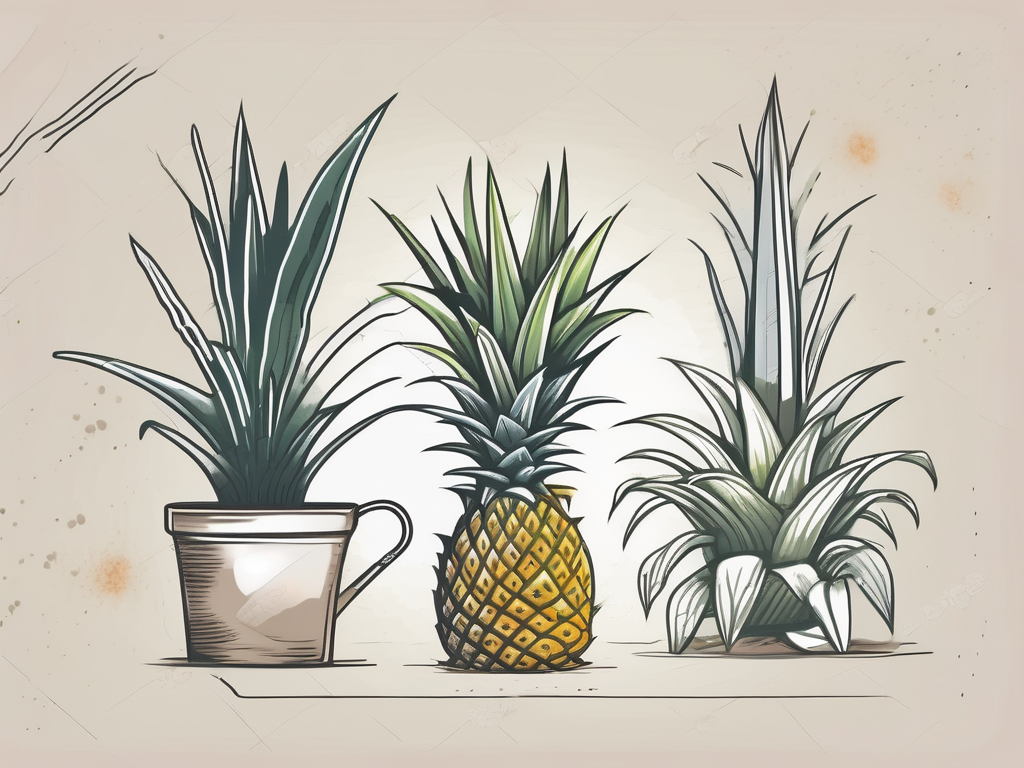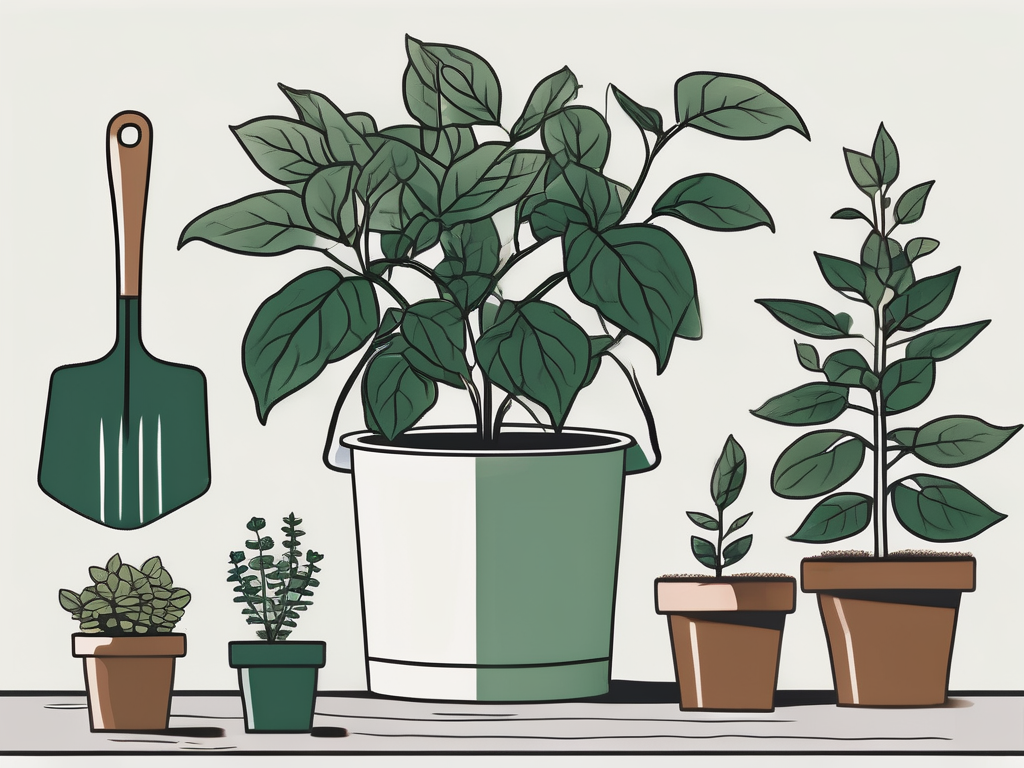
Have you ever looked at a pineapple and thought, "I bet I could grow one of those"? You're not alone! The pineapple bromeliad, with its unique appearance and tropical vibes, is a fantastic plant to have at home. Whether you're a seasoned plant parent or just starting out, propagating a pineapple bromeliad can be a satisfying project.
In this post, we'll walk you through every step of the process, from choosing the right pineapple to nurturing your new plantlets. By the end, you'll have the confidence to try this exciting propagation method and add a touch of the tropics to your space. Let's get growing!
Choosing the Right Pineapple
Before you can start propagating, you need a pineapple. But not just any pineapple will do. A healthy, ripe pineapple with a vibrant crown is your best bet. The crown is the leafy top of the pineapple, and it’s the part you'll be using for propagation.
When selecting your pineapple, look for the following:
- Healthy Leaves: The leaves should be green and firm, not yellowing or browning. Avoid crowns with any signs of rot or damage.
- Ripe Fruit: The body of the pineapple should be firm, with a slight give when pressed. It should also have a sweet aroma at the base.
- No Fungus or Pests: Check for any signs of pests or fungal infections. The last thing you want is to bring unwanted guests into your home!
Once you've chosen your pineapple, it’s time to prepare the crown for propagation. Excited yet? Let’s move on to the next step.
Preparing the Pineapple Crown
Now that you have the perfect pineapple, it's time to get your hands a little dirty—figuratively speaking, of course! Preparing the pineapple crown is a straightforward process, but it does require a bit of care and attention.
Here's how to do it:
- Remove the Crown: Firmly grasp the base of the crown with one hand and the body of the pineapple with the other. Twist the crown until it separates from the fruit. You should be left with a leafy top and a small section of the fruit attached.
- Trim Excess Fruit: Use a sharp knife to carefully remove any excess fruit from the base of the crown. You want to expose the stem without damaging it.
- Remove Lower Leaves: Gently peel away a few layers of the lower leaves to reveal about one inch of the stem. This helps the crown develop roots more easily.
- Dry the Crown: Allow the crown to dry for a day or two. This step is crucial as it helps prevent rot when you start the rooting process.
With the crown prepped and ready, you're well on your way to growing your own pineapple plant. The anticipation of seeing those first roots is all part of the fun!
Rooting the Pineapple Crown
Rooting the pineapple crown is where the magic starts. This stage is all about patience, as it can take several weeks for roots to develop. But don't worry, it's a simple process that just requires a bit of time and care.
Here's what you'll need to do:
- Choose a Container: A glass jar or a small vase works perfectly. You want something that will support the crown while allowing the base to be submerged in water.
- Add Water: Fill the container with enough water to cover the exposed stem, but not the leaves. The water should be changed every few days to keep it fresh and oxygenated.
- Place in a Warm Spot: Find a sunny window or a warm area in your home. Pineapple bromeliads thrive in warmth, and this will encourage root growth.
- Monitor for Roots: After a couple of weeks, you should start to see roots emerging from the base of the stem. Be patient, as this can sometimes take a bit longer.
Once the roots are a few inches long, you’ll be ready to pot your new plant. Watching those roots grow is like watching nature’s slow reveal—it’s truly satisfying!
Potting Your Pineapple Plant
With roots well established, your pineapple crown is ready to be potted. Choosing the right pot and soil is important to ensure your new plant continues to thrive. Let's dig into the details.
Follow these steps to pot your pineapple bromeliad:
- Select a Pot: Choose a pot with drainage holes to prevent water from collecting at the bottom. A pot that's 6-8 inches in diameter is a good starting size.
- Prepare the Soil: Use a well-draining potting mix. You can mix regular potting soil with sand or perlite to improve drainage.
- Plant the Crown: Make a small hole in the center of the pot and place the crown in it, then gently pack the soil around the base. Ensure the base is level with the soil surface.
- Water Lightly: Give the plant a light watering. You want the soil to be moist but not soggy.
Now that your pineapple plant is potted, it’s time to focus on care and maintenance. Keep reading for tips on how to keep your new plant healthy and happy.
Providing the Right Conditions
Creating the ideal environment for your pineapple bromeliad is crucial for its growth and well-being. These tropical plants have specific needs, but once you understand them, they're fairly easy to maintain.
Here’s what to consider:
- Light: Pineapple bromeliads love bright, indirect sunlight. A south or east-facing window is ideal. Too much direct sunlight can scorch the leaves, while too little can stunt growth.
- Temperature: These plants prefer warm temperatures, ideally between 65-85°F (18-29°C). Protect them from cold drafts, which can cause stress.
- Humidity: Being tropical plants, they thrive in higher humidity. If your home is dry, consider using a humidifier or placing a tray of water near the plant.
By meeting these basic needs, you’ll give your pineapple bromeliad the best chance to flourish. And remember, plants are living things—they’ll let you know if something's not quite right!
Watering and Feeding Your Pineapple Bromeliad
When it comes to watering and feeding, finding the right balance is essential. Overwatering is a common issue, so it’s important to get it just right.
Consider these tips:
- Watering: Allow the top inch of soil to dry out between waterings. In the growing season (spring and summer), water more frequently. In the dormant season (fall and winter), reduce watering.
- Feeding: Use a balanced liquid fertilizer once a month during the growing season. Pineapple bromeliads aren’t heavy feeders, so be careful not to over-fertilize.
- Water in the Rosette: In addition to soil watering, you can keep a small amount of water in the central rosette of the plant. This mimics their natural habitat.
By keeping an eye on your plant's watering needs and feeding it appropriately, you'll support its growth and vitality. And let’s face it, there’s something quite zen about caring for plants.
Dealing with Common Problems
Even with the best care, plants can sometimes face challenges. Knowing how to spot and address these issues can make all the difference.
Here are a few common problems and solutions:
- Yellowing Leaves: This could be a sign of overwatering. Check the soil moisture and adjust your watering schedule accordingly.
- Brown Leaf Tips: Often caused by dry air or over-fertilization. Increase humidity or reduce feeding to see if the problem improves.
- Pests: Watch out for common pests like aphids or spider mites. Treat infestations with insecticidal soap or neem oil.
Remember, plants are resilient. With a little attention and care, most issues can be resolved, and your pineapple bromeliad will be back to its healthy self.
When to Expect Your First Pineapple
Growing a pineapple takes time, but the wait is worth it. Patience is key, as it can take a couple of years for your plant to produce fruit.
Here's what to expect:
- Plant Maturity: Generally, a pineapple bromeliad will take 2-3 years to mature and begin producing a fruit.
- Flowering: The plant will first produce a flower, which is an exciting stage! The flower will eventually develop into the fruit.
- Fruit Development: Once flowering begins, it can take another 6 months for the fruit to fully develop and ripen.
Growing your own pineapple is a rewarding endeavor. While it requires patience, there’s something magical about nurturing a plant from crown to fruit.
Sharing Your Pineapple Bromeliad Journey
One of the best parts of plant propagation is sharing your success with others. Whether it’s gifting a plantlet to a friend or sharing your progress on social media, it’s a great way to celebrate your green-thumb achievements.
Here are a few fun ways to share your journey:
- Photo Updates: Document your plant's growth with photos. It's a fun way to see how much progress you've made.
- Gift a Plantlet: If your pineapple bromeliad produces pups (baby plants), consider sharing them with friends or family.
- Join Online Communities: Connect with other plant lovers online. Sharing tips and experiences can be both educational and inspiring.
Sharing your journey not only spreads joy but also encourages others to try their hand at propagation. Plus, who doesn’t love a bit of plant talk?
Final Thoughts
Growing a pineapple bromeliad from a crown is a delightful journey of patience and reward. From selecting the perfect pineapple to nurturing your plant to maturity, each step brings you closer to enjoying your very own homegrown fruit.
At Cafe Planta, we’re passionate about helping plant people thrive. We offer a variety of houseplants and care accessories to support your green adventures. If you have any questions or just want to share your plant stories, feel free to email us or send us a DM on Instagram. We're here to help you create a beautiful, thriving plant collection in your home!












